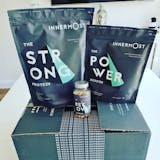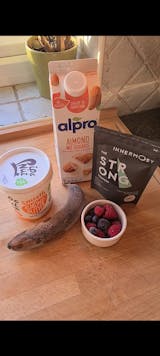It’s almost that time of the year again. With the long cold nights of January finally over and Autumn/spring on the horizon, we’re slowly approaching what we like to call ‘half marathon season’. A time that starts with signing up for an event and wondering how to put a training plan into place and ends with the sense of accomplishment and runner-high that is so unique to the sport.
But this is assuming you’ve gone through this dance before. The question is how do you approach this distance if you’re new to running? Is it something that is even achievable in 15 weeks?
While the short answer is of course! The longer answer? Read on!
Below we’ve included our complete guide to the half marathon for those who are completely new to the distance, and event, or even to running itself. What’s more, our training plan details just how you can build up your fitness levels as a beginner from zero to race day ready.
Why the half marathon?
Before committing to running a half marathon, it’s important to ask and understand why you would want to run the 21.1k instead of a shorter 5k -10k or even a 42.2k marathon distance.
While either of these options is definitely doable – whatever your ability – the half marathon provides the perfect middle ground in terms of distance. Something that is achievable within a reasonable timeframe and will provide a genuine challenge, but without needing days or weeks to recover.
To seal the deal even further, a half marathon also has the benefits of:
Improved health
An effective half marathon training plan will see you do more than just run. It also includes strength training, endurance, flexibility and balance, keeping your whole body at tip top fitness and improving things like cardiovascular and general health
Confidence boosting:
As a runner myself, I can attest. There isn’t a feeling much better than setting a goal, going through the half marathon running plan and coming out at the end having smashed your distance target. It taught me that I can do almost anything if I put my mind to it.
Social community:
Whether you’re deep into training or at the event itself, the half marathon has such a vibrant community of like-minded individuals who you can share the experience with.
Half marathon training exercises
To make your training a little easier, we’ve have outlined a list of workouts to complete as part of your training plan and their benefits on the body.
Running endurance exercises
No surprises, but your training should consist of plenty of running workouts of different intensities and approaches.
Intuitive running workouts
Intuitive Runs are all about listening to your body. There is no distance target, no pace goal and no pressure.
It’s all about running at a conversational and comfortable pace (don’t fret if you have to start walking), offering a chill experience to build a positive relationship with running. This one is particularly good to experience with a friend or community of runners.
Beginner runs
As the name suggests, these beginner runs are where most training plans should start – especially for those who have never really been into running. These slower, conversational-paced runs are all about building up your aerobic capacity; initially starting at the slowest speed and with each run getting slightly faster.
Interval running
Interval (or intermittent) running exercises are just that – runs where you switch between high- and low-intensity pace at regular intervals.
While more challenging than the beginner run, interval training has the benefit of increasing your body’s lactate threshold as well as improving running efficiency. In layman’s terms you’re training your body to use less energy at the same pace, allowing you to more comfortably sustain a pace during a half marathon run.
Long distance runs
Long-distance runs are the cornerstone to any half-marathon training plan. They help build your body’s endurance and are generally fantastic at building a runner's confidence for event day. It is however fundamental to get them right to avoid injury and burnout.
Consistency: Improvement and injury avoidance is all about getting the right number of endurance runs in from day 1 to run day. Try and aim for 1 long-distance workout per week for the perfect balance.
Building tolerance: If you’re just starting out on your running journey, you need to start slow and short and gradually build up pace and distance. Generally, your running plan should follow a “10% rule” where between runs, the distance is increased by no more than 10%.
Gear and nutrition: Nutrition - as well as what you wear – plays a major role in how your body performs on race day. Long runs are a great time to experiment with different protein shakes and gels that work for you – avoiding any surprises or other worries on the big day.
Recovery: Stretching before and after, getting the right amount of sleep and eating the right foods are key to improving the recovery process. Again, try and get into a routine long before race day to avoid any unexpected impacts.
Focused runs
Focused runs allow you to tailor pace and distance to whatever it is you need to improve on. For instance, preparing for the hills of a half marathon? You might choose targeted incline runs one session and interval runs the next.

Strength exercises
Strength workouts should also play a part in your half-marathon training plan as unlike running workouts alone, trained muscles, improve running form, power, and stability, helping to reduce your chances of injury during the run.
Don’t worry, we’ve included a few workouts that can be tailored to your ability - making them perfect for everyone from beginner to specialist.
Lower body strength workouts
Squats: To make the most of your squats, stand feet shoulder-width apart and lower your hips as if you're sitting in a chair. Keep your back straight, chest up, and knees tracking over your toes
Lunges: Step forward with your right leg and lower your hips until both knees are bent at 90 degrees. Push back up to the starting position and repeat with your left leg.
Glute bridges: Lie on your back with your knees bent and feet flat on the floor. Lift your hips off the ground, squeezing your glutes at the top
Core strength workout
Planks: Start on your hands and knees, then lower onto your forearms. Keep your body in a straight line from head to heels. Hold for 30 seconds, gradually increasing the hold time as you get stronger.
Dead bugs: Lie on your back with arms extended towards the ceiling and knees bent at 90 degrees. Lower your right arm and left leg simultaneously towards the floor, keeping your lower back pressed against the ground. Return to the starting position and repeat with your left arm and right leg
Bicycle crunches: Lie on your back with hands behind your head and knees bent. Bring the opposite elbow to the knee while extending the other leg.
Upper body strength
Push-ups: Start in a plank position and lower your chest towards the ground by bending your elbows. Push back up to the starting position
Rows: Pull a resistance band or dumbbells towards your chest, engaging your back muscles.
Overhead press: Press dumbbells overhead, strengthening your shoulders.
![]()
 How long does it take to train for a half marathon?
How long does it take to train for a half marathon?
This is another question that beginners and professionals alike wonder to themselves. How much time should I give myself on my training plan to be 21k ready? While this can depend largely on the individual, for a beginner we would suggest giving yourself no less than 16 weeks training to allow for a gradual build up in fitness and reduce your chance of injury.
What is a respectable half marathon time?
It’s one of the most frequently asked half-marathon questions we get asked. “What is a good half marathon time?” Often quickly followed by “and what sort of training plan do I need to hit this target”. The answer is always the same – a good run time is entirely based on what you can achieve.
Sure we can point out arbitrary time averages, but things like age, gender, experience, training background, injury history, and personal goals all play a significant role. If this is your first time taking part in the run then your main goal should be to cross the line, anything else you decide to aim for should be something you are realistically able to achieve.
Time to get half marathon ready!
So there you have it!
You might not think it, but a half marathon is completely achievable in a smaller amount of time than you probably think, so why not consider signing up to your first today?
For added energy, muscle growth and repair, why not consider one of our science backed protein powders such as The Fit Protein?
























